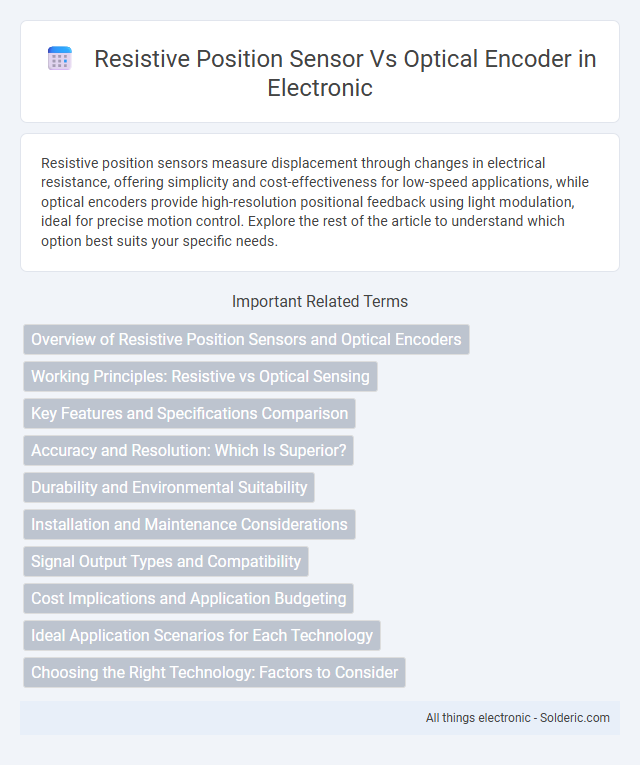Resistive position sensors measure displacement through changes in electrical resistance, offering simplicity and cost-effectiveness for low-speed applications, while optical encoders provide high-resolution positional feedback using light modulation, ideal for precise motion control. Explore the rest of the article to understand which option best suits your specific needs.
Comparison Table
| Feature | Resistive Position Sensor | Optical Encoder |
|---|---|---|
| Operating Principle | Measures position via variable resistance change | Measures position using light interruption or reflection |
| Accuracy | Moderate (+-0.5% to +-1%) | High (up to +-0.01% or better) |
| Resolution | Limited by resistance steps and noise | High resolution via optical disk patterns |
| Durability | Wear-prone due to mechanical contact | Non-contact, long lifespan |
| Environmental Sensitivity | Sensitive to dust, humidity, and temperature | Generally resistant; sensitive to heavy contamination |
| Cost | Low to moderate | Moderate to high |
| Typical Applications | Simple position feedback, volume controls | Precision robotics, CNC machines, industrial automation |
Overview of Resistive Position Sensors and Optical Encoders
Resistive position sensors detect displacement by measuring the change in electrical resistance along a resistive element, offering simplicity and cost-effectiveness for applications with moderate accuracy requirements. Optical encoders use light interruption or reflection to track position with high precision and resolution, making them ideal for complex motion control systems. Your choice depends on factors like required accuracy, environment, and budget constraints, as resistive sensors excel in rugged conditions, while optical encoders deliver superior performance in precision-dependent applications.
Working Principles: Resistive vs Optical Sensing
Resistive position sensors operate by measuring changes in electrical resistance as a wiper moves across a resistive element, translating physical displacement into a variable voltage signal. Optical encoders utilize light interruption or reflection, detecting position by counting pulses generated from a rotating code wheel with photodetectors. Your choice depends on the precision needed; resistive sensors offer simplicity and robustness, while optical encoders provide higher resolution and accuracy through non-contact optical measurement.
Key Features and Specifications Comparison
Resistive position sensors offer high durability with simple construction, providing analog output signals ideal for continuous position feedback in harsh environments, typically featuring resistance ranges from a few ohms to several kilo-ohms and measurement accuracy around +-1%. Optical encoders provide precise digital position feedback using light interruption or reflection, delivering higher resolution up to thousands of pulses per revolution and faster response times, often preferred in applications requiring high accuracy and repeatability. Your choice depends on the environment and precision needs, with resistive sensors excelling in robustness and optical encoders in resolution and speed.
Accuracy and Resolution: Which Is Superior?
Optical encoders generally offer superior accuracy and resolution compared to resistive position sensors due to their ability to detect fine increments of movement using light patterns. Typical optical encoders provide resolutions up to 10,000 pulses per revolution or more, enabling precise positioning in applications like robotics and automation. Resistive position sensors, relying on variable resistance, usually have lower resolution and accuracy, often limited by material properties and signal noise.
Durability and Environmental Suitability
Resistive position sensors offer high durability with robust resistance to shock, vibration, and dust, making them suitable for harsh industrial environments. Optical encoders are more sensitive to contaminants like dust, moisture, and oil, which can degrade performance and require protective sealing for reliable operation. The choice between the two depends on environmental conditions, with resistive sensors preferred for rugged, dirty settings and optical encoders favored for clean, precise applications.
Installation and Maintenance Considerations
Resistive position sensors offer straightforward installation with minimal alignment requirements, making them suitable for compact or constrained spaces. Optical encoders demand precise mounting and alignment to ensure accurate signal output, often requiring calibration during installation. Maintenance of resistive sensors generally involves periodic cleaning to prevent wear on the wiper and track, whereas optical encoders necessitate protection from dust and vibration to avoid signal degradation and maintain longevity.
Signal Output Types and Compatibility
Resistive position sensors typically provide an analog voltage output proportional to the position, making them compatible with standard analog signal processing systems. Optical encoders generate digital pulses or quadrature signals, enabling precise position tracking and seamless integration with digital control systems and microcontrollers. Choosing between these sensor types depends on your system's signal requirements and compatibility with analog or digital interfaces.
Cost Implications and Application Budgeting
Resistive position sensors generally offer lower upfront costs compared to optical encoders, making them more suitable for budget-sensitive applications or projects with stringent cost constraints. Optical encoders, while more expensive, provide higher precision and reliability, justifying their investment in applications demanding accurate position feedback and long-term durability. Evaluating your application's performance requirements alongside cost implications ensures optimal budgeting and avoids overspending on unnecessarily advanced technology.
Ideal Application Scenarios for Each Technology
Resistive position sensors excel in applications requiring simple, cost-effective solutions for measuring linear or angular displacement with moderate precision, such as throttle position sensing in automotive systems or joystick controls in consumer electronics. Optical encoders are ideal for high-accuracy and high-resolution requirements in industrial automation, robotics, and CNC machinery where precise feedback on position, speed, or direction is critical. Your choice depends on the accuracy, environmental conditions, and budget constraints of your specific application.
Choosing the Right Technology: Factors to Consider
When choosing between a resistive position sensor and an optical encoder, consider factors such as accuracy requirements, environmental conditions, and budget constraints. Resistive sensors excel in cost-effectiveness and simplicity but may suffer from wear and limited precision, while optical encoders provide high resolution and durability in clean environments. Your application's need for long-term reliability and precision will guide the optimal technology selection.
resistive position sensor vs optical encoder Infographic

 solderic.com
solderic.com